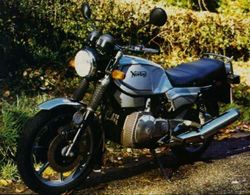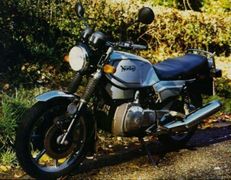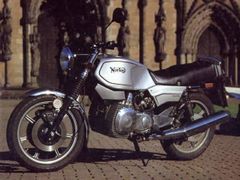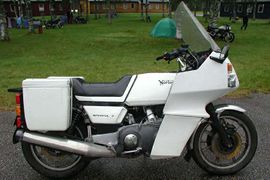Norton Interpol 2 Classic
 |
|
| Norton Interpol 2 Classic | |
| Manufacturer | |
|---|---|
| Production | 1988 |
| Engine | Air Cooled, Twin Chamber, Rotary |
| Compression ratio | 9.0:1 |
| Horsepower | 85.02 HP (63.4 KW) @ 9000RPM |
| Torque | 55.32 ft/lbs (75.0 Nm) @ 7000RPM |
| Fuel System | 2x 38mm CV SUH14 Carburetors |
| Ignition | Electronic CDI, 2 x 12V coils |
| Transmission | 5 Speed |
| Suspension | Front: Ø38 mm Telescopic forks 130mm wheel travel. Rear: Twin Girling gas units, 3-way preload |
| Brakes | Front: 2 x Ø265 mm discs Rear: Single Ø265 mm disc |
| Front Tire | 100/90-18 |
| Rear Tire | 110/80-18 |
| Weight | |
| Fuel Capacity | 23 L / 6.1 US gal |
| Manuals | Service Manual |
The Norton INTERPOL 2 CLASSIC was a Air Cooled, Twin Chamber, Rotary Naked motorcycle produced by Norton in 1983. Max torque was 55.32 ft/lbs (75.0 Nm) @ 7000 RPM. Claimed horsepower was 85.02 HP (63.4 KW) @ 9000 RPM.
The Interpol 2 is a Norton motorcycle produced from 1984 to 1989. It has an air-cooled twin rotor 588 cc Wankel engine. This machine was designated Interpol 2A. When production of the Interpol 2 ceased it was succeeded by the P52 version of the Norton Commander.
Engine[edit | edit source]
The engine was a Air cooled cooled Twin chamber rotary. The engine featured a 9.0:1 compression ratio.
Drive[edit | edit source]
Power was moderated via the Progressive multi-plate.
Chassis[edit | edit source]
It came with a 100/90-18 front tire and a 110/80-18 rear tire. Stopping was achieved via 2 x Ø265 mm discs in the front and a Single Ø265 mm disc in the rear. The front suspension was a Ø38 mm Telescopic forks 130mm wheel travel. while the rear was equipped with a Twin Girling gas units, 3-way preload. The Interpol 2 Classic was fitted with a 23 L / 6.1 US gal fuel tank.
Photos[edit | edit source]
Overview[edit | edit source]
If you know anything about these motorcycles, it will be obvious to you that the author of the below is spouting mostly uninformed bollocks.
Only an earlier Rotary, Suzuki's calamitous RE5 or Hercules W2000, but rather wimpish Wankel, can prepare you for a ride on the Norton Rotary. While its controls are virtually the same as those of any conventionally-engined bike, the manner in which it responds to them is most certainly not. From cold, the big (and ugly) 38mm SU constant vacuum carbs require a decent wodge of choke, courtesy of the dash-mounted knob, and the engine runs a tad rough until it's had a few minutes to warm up.
Although rough in the case of the Wankel never means that it oscillates in an intemperate fashion, it just means it sounds a bit weird - and splutters. When you've got beyond that, tickover settles down to an impressive 500rpm or so, and after you've utilised the light and extremely progressive multiplate clutch to snick into bottom gear, you can pull away cleanly just 500rpm further up the chimney. Suspicions that the two-stroke analogies of the rotary principle might mean a narrow powerband are quickly dispelled, for this package pulls from around 1500rpm and 20mph in top gear, almost right up to its 9000rpm maximum power point. At least in its top-of the-range 9:1 compression trim.
The liquid-cooled version I rode (not the air-cooled one in the pix), was burdened with a 500lb-weight of police-spec fairing and other law enforcement encumbrances which prevented it from travelling beyond 120mph - or at least without feeling distinctly wobbly. But with an indicated 17mph per 1000rpm in top, and 90mph at a leisurely 6000rpm on the same cog (and we're talking police calibrated speedo here), I assume that an ultimate velocity of 140mph is not beyond the bounds of reason. And considering that the Wankel displaces 588cc, that makes it a very nippy middleweight twin, no?! The bounds of reason are, thankfully, fettered by an electronic rev-limiter which restores sanity at 10,000rpm and an electronic CDI ignition fed by two 12-volt coils. A feature of the ignition is an electronic retard unit incorporating an electronic temperature sensor to optimise combustion efficiency. This is further enhanced by the engine's cooling system which draws filtered air through the frame and fins to the bowels of the engine before it reaches the SUs. Except on the liquid-cooled engines, where it doesn't.
In operation, of course, the engine is extremely smooth and mechanically quiet - hence the need for the rev limiter. In these respects riding the rotor-cycle is really an uncannily different experience, and ultimately a very pleasant one, for the exhaust note compensates for unfamiliar engine feedback with a rewardingly fulsome roar - although even that is like nothing else I can readily bestow cliches on.
With only an afternoon on the bike, I clearly can't report comprehensively on the riding experience, but despite the Plod-like accoutrements, and stiffish suspension and seat, I can confirm that it's a supremely fatigue-free deal. Unfortunately I did have some problems with the handling, though.
On slowish corners I found understeer up to the apex of the bend quickly giving way to oversteer thereafter. This was a bit disconcerting, and required a certain mental preparation when negotiating tight twisties, but the problem disappeared beyond about 55/60mph when the steering became pretty neutral, although erring slightly to oversteer as per the current fashion. Some of this might be down to the heavy fairing; Dave Evans told me that spacers of 1 to 1.75in are inserted above the fork springs to suit personal tastes, as rake and trail measurements of 28°mm/127mm respectively, should make for the aforementioned neutrality in almost all conditions.
Only once did untoward zeal get me into a bum-clenching situation, and that was when I went into what looked like a long sweeper but tightened suddenly into something else. Shutting off the power on the Norton doesn't have the same effect as a four-stroke - there's a lot less engine braking even when it may seem prudent to use it, but the oversteer meant I had to do something to avoid oncoming traffic, and that something was a dab on the brakes; fortunately Brembo country is familiar country, and a slight snake at the rear end out of trouble. Lever pressure is fairly minimal and sensitivity fairly good, but the rear brake seemed to be suffering from that stodgy, rather inert feeling that you sometimes get with the Italian retardants. Tyres on my test bike were Avon Super Venoms, 120/90 rear and 100/80 x 18, front, and proved suitably sticky even in patchy, wet 'n' dry conditions. It wasn't until I voiced my concern on the handling and phoned Mr Denniss to check tire pressures that I discovered the front cover was running 7psi below par, which probably explains everything.
Notwithstanding this one and only caveat, my initial impression of the liquid-cooled rotor-bike is entirely favourable. A few rough edges perhaps, most of them hopefully on the list posted in the management suite, but like Ducati and BMW, here is a machine which by virtue of uncompromised and distinctly different engine design, has a spirit and a character that is truly unique. And as those equally venerable German and Italian marques have proven, that sells bikes. Expensive
Source Motorcycle International 1988
| Make Model. | Norton Interpol 2 Classic |
|---|---|
| Year | 1988 |
| Engine Type | Twin chamber rotary |
| Displacement | 588 cc / 35.9 cu in |
| Compression | 9.0:1 |
| Cooling System | Air cooled |
| Induction | 2 x Ø38 mm CV SUH14 |
| Ignition | Electronic CDI, 2 x 12V coils |
| Starting | Electric |
| Max Power | 63.4 kW / 85 hp @ 9000 rpm |
| Max Torque | 75.3 Nm / 7.69 kgf-m / 55.6 lb-ft @ 7000 rpm |
| Clutch | Progressive multi-plate |
| Transmission | 5 Speed |
| Final Drive | Chain |
| Rake | 28° |
| Trail | 127 mm / 5.0 in |
| Front Suspension | Ø38 mm Telescopic forks 130mm wheel travel. |
| Front Wheel Travel | 130 mm / 5.1 in |
| Rear Suspension | Twin Girling gas units, 3-way preload |
| Front Brakes | 2 x Ø265 mm discs |
| Rear Brakes | Single Ø265 mm disc |
| Front Tire | 100/90-18 |
| Rear Tire | 110/80-18 |
| Dry-weight | 235 kg / 518 lbs |
| Fuel Capacity | 23 L / 6.1 US gal |


